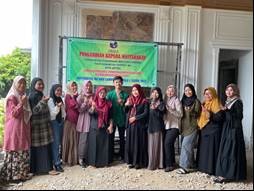Keywords: Islamic Investment, PAC Fatayat Metro Utara, Investment Fraud, Sharia investment
Abstract
In Indonesia, there are two primary investment forms: conventional and sharia. Many people need help understanding the difference between the two. Sharia investment is an investment that is based on Islamic principles and laws. This study aims to improve the understanding of sharia investment in the PAC Fatayat Metro Utara community in Metro City. Currently, many community members do not understand the concept of sharia investment properly, so they are still vulnerable to investment fraud that is not legally clear and promises large profits in a short time. Awareness of the importance of investment as long-term savings that can provide benefits in the future needs to be increased. This is important so that people are aware of investment offers that have been rampant lately, especially investments that claim to be Sharia-based but are not by Islamic principles. This study found that the PAC Fatayat Metro Utara community's understanding of sharia investment could be more robust. Therefore, more intensive education and socialization are needed so that this community can recognize and choose investments based on Sharia principles and avoid fraudulent investments. By increasing public understanding, especially among the PAC Fatayat Metro Utara community, it is hoped that the number of investment fraud victims under Sharia's guise can be minimized. Proper education will have a long-term positive impact on the economic welfare of society.
References
Afifipour, M. (2011). Interaction of twin tunnels and shallow foundation at Zand underpass, Shiraz metro, Iran. Tunnelling and Underground Space Technology, 26(2), 356–363. https://doi.org/10.1016/j.tust.2010.11.006
Alias, N. (2014). From state Islamic religious schools to Syariah and legal studies: Human resource in the Islamic sector and academic entrepreneurship in Malaysian higher education institutions. Pertanika Journal of Social Science and Humanities, 22, 223–238.
Alvizu, R. (2017). Matheuristic with machine-learning-based prediction for software-defined mobile metro-core networks. Journal of Optical Communications and Networking, 9(9). https://doi.org/10.1364/JOCN.9.000D19
Ashcraft, M. (2002). Math anxiety: Personal, educational, and cognitive consequences. Current Directions in Psychological Science, 11(5), 181–185. https://doi.org/10.1111/1467-8721.00196
Barnet, B. (2009). Maximizing transportation investments: Collaborative fraud prevention and outreach. Public Roads, 72(5).
Bawono, B. T. (2024). The Impact of Islamic Economics Principles on the Tax Compliance Payment Entertainment Policy. Juris: Jurnal Ilmiah Syariah, 23(1), 107–127. https://doi.org/10.31958/juris.v23i1.12182
Benardos, A. G. (2004). A methodology for assessing geotechnical hazards for TBM tunnelling - Illustrated by the Athens Metro, Greece. International Journal of Rock Mechanics and Mining Sciences, 41(6), 987–999. https://doi.org/10.1016/j.ijrmms.2004.03.007
Biesta, G. (2015). What is education for? On Good education, teacher judgement, and educational professionalism. European Journal of Education, 50(1), 75–87. https://doi.org/10.1111/ejed.12109
Busni, D. (2022). Implementation of the Hybrid Contract Concept in Multiservice Ijarah Financing as a Financing Alternative Health Service in the Covid-19 Pandemic. Juris: Jurnal Ilmiah Syariah, 21(1), 11–26. https://doi.org/10.31958/juris.v21i1.5173
Chameides, W. L. (1994). Growth of continental-scale metro-agro-plexes, regional ozone pollution, and world food production. Science, 264(5155), 74–77.
Ciccarelli, F. (2012). Control of metro-trains equipped with onboard supercapacitors for energy saving and reduction of power peak demand. Transportation Research Part C: Emerging Technologies, 24, 36–49. https://doi.org/10.1016/j.trc.2012.02.001
Cignoni, P. (1998). Metro: Measuring Error on Simplified Surfaces. Computer Graphics Forum, 17(2), 167–174. https://doi.org/10.1111/1467-8659.00236
Coletti, C. (2011). Deployment of LTE in-band relay and micro base stations in a realistic metropolitan scenario. IEEE Vehicular Technology Conference. https://doi.org/10.1109/VETECF.2011.6093073
Creti, A. (2014). Fraud, investments and liability regimes in payment platforms. International Journal of Industrial Organization, 35(1), 84–93. https://doi.org/10.1016/j.ijindorg.2014.06.003
Crevier, L. P. (2001). METRo: A new model for road-condition forecasting in Canada. Journal of Applied Meteorology, 40(11), 2026–2037. https://doi.org/10.1175/1520-0450(2001)040<2026:MANMFR>2.0.CO;2
David, L. (2014). Finance Capital, Actor-Network Theory and the Struggle Over Calculative Agencies in the Business Property Markets of Mexico City Metropolitan Region. Regional Studies, 48(3), 516–529. https://doi.org/10.1080/00343404.2012.756581
Davis, M. (2003). What’s wrong with character education? American Journal of Education, 110(1), 32–57. https://doi.org/10.1086/377672
Deegan, D. (2016). Practical Skills Training in Agricultural Education—A Comparison between Traditional and Blended Approaches. Journal of Agricultural Education and Extension, 22(2), 145–161. https://doi.org/10.1080/1389224X.2015.1063520
Derrible, S. (2010a). Characterizing metro networks: State, form, and structure. Transportation, 37(2), 275–297. https://doi.org/10.1007/s11116-009-9227-7
Derrible, S. (2010b). The complexity and robustness of metro networks. Physica A: Statistical Mechanics and Its Applications, 389(17), 3678–3691. https://doi.org/10.1016/j.physa.2010.04.008
Derrible, S. (2012). Network centrality of metro systems. PLoS ONE, 7(7). https://doi.org/10.1371/journal.pone.0040575
Devaney, S. (2017). Which factors determine transaction activity across U.S. metropolitan office markets? Journal of Portfolio Management, 43(6), 90–104. https://doi.org/10.3905/jpm.2017.43.6.090
Djawas, M. (2022). The Construction of Islamic Inheritance Law: A Comparative Study of the Islamic Jurisprudence and the Compilation of Islamic Law. Juris: Jurnal Ilmiah Syariah, 21(2), 207–219. https://doi.org/10.31958/juris.v21i2.7495
Dunn, T. J. (2019). Technology Enhanced Learning in higher education; motivations, engagement and academic achievement. Computers and Education, 137, 104–113. https://doi.org/10.1016/j.compedu.2019.04.004
Falvo, M. C. (2011). Energy management in metro-transit systems: An innovative proposal toward an integrated and sustainable urban mobility system including plug-in electric vehicles. Electric Power Systems Research, 81(12), 2127–2138. https://doi.org/10.1016/j.epsr.2011.08.004
Florida, R. (2009). There goes the metro: How and why bohemians, artists and gays affect regional housing values. Journal of Economic Geography, 10(2), 167–188. https://doi.org/10.1093/jeg/lbp022
Florida, R. (2016). The Geography of Inequality: Difference and Determinants of Wage and Income Inequality across US Metros. Regional Studies, 50(1), 79–92. https://doi.org/10.1080/00343404.2014.884275
Fraud. Conviction upheld in bogus HIV drug investment scheme. (2003). AIDS Policy & Law, 18(19), 8.
Frey, W. H. (1996). Latino, Asian, and black segregation in U.S. metropolitan areas: Are multiethnic metros different? Demography, 33(1), 35–50. https://doi.org/10.2307/2061712
Gainsborough, J. F. (2003). Business Organizations as Regional Actors: The Politics of Regional Cooperation in Metropolitan America. Polity, 35(4), 555–572. https://doi.org/10.1086/POLv35n4ms3235453
Ghazali, M. (2015). Sharia compliant gold investment in Malaysia: Hedge or safe haven? Pacific Basin Finance Journal, 34, 192–204. https://doi.org/10.1016/j.pacfin.2014.12.005
Guri-Rosenblit, S. (2005). “Distance education” and “e-learning”: Not the same thing. Higher Education, 49(4), 467–493. https://doi.org/10.1007/s10734-004-0040-0
Hagel, L. M. (2008). Prevention of agricultural injuries: An evaluation of an education-based intervention. Injury Prevention, 14(5), 290–295. https://doi.org/10.1136/ip.2008.018515
Holakooei, P. (2018). Early Islamic pigments at Nishapur, north-eastern Iran: studies on the painted fragments preserved at The Metropolitan Museum of Art. Archaeological and Anthropological Sciences, 10(1), 175–195. https://doi.org/10.1007/s12520-016-0347-7
İnal, K. (2024). Argumentation in Religious Education-An Analysis on German Islamic Religion Textbooks. Journal for Critical Education Policy Studies, 22(1), 316–356.
Investment fraud: The cockroaches of finance. (2016). Economist (United Kingdom), 412(8969).
Iwatsuki, K. (2004). Access and metro networks based on WDM technologies. Journal of Lightwave Technology, 22(11), 2623–2630. https://doi.org/10.1109/JLT.2004.834492
James, P. A. (1991). Using the cooperative extension service in agricultural health education. Occupational Medicine (Philadelphia, Pa.), 6(3), 519–527.
Jianfeng, K. (2013). TD-LTE network indoor performance with Micro and Femto deployment in a realistic metropolitan scenario. IEEE Wireless Communications and Networking Conference, WCNC, 3948–3952. https://doi.org/10.1109/WCNC.2013.6555207
Ji, Y. (2018). Exploring spatially varying influences on metro-bikeshare transfer: A geographically weighted poisson regression approach. Sustainability (Switzerland), 10(5). https://doi.org/10.3390/su10051526
Kasim, M. A. (2014). Investment in non-Sharia compliant instruments wrecks TH’s noble reputation: a challenge to regain public confidence. Emerald Emerging Markets Case Studies, 4(2), 1–17. https://doi.org/10.1108/EEMCS-07-2013-0128
Komalasari, K. (2018). The influence of living values education-based civic education textbook on student’s character formation. International Journal of Instruction, 11(1), 395–410. https://doi.org/10.12973/iji.2018.11127a
Krapp, A. (1999). Interest, motivation and learning: An educational-psychological perspective. European Journal of Psychology of Education, 14(1), 23–40. https://doi.org/10.1007/BF03173109
Lee, M. R. (2003). Social isolation and lethal violence across the metro/nonmetro divide: The effects of socioeconomic disadvantage and poverty concentration on homicide. Rural Sociology, 68(1), 107–131. https://doi.org/10.1111/j.1549-0831.2003.tb00131.x
Lindsay, G. (2007). Educational psychology and the effectiveness of inclusive education/mainstreaming. British Journal of Educational Psychology, 77(1), 1–24. https://doi.org/10.1348/000709906X156881
Lioutas, E. D. (2010). Small ruminant producers’ training needs and factors discouraging participation in agricultural education/training programs. Livestock Research for Rural Development, 22(7).
Li, Q. (2017). A new approach to understand metro operation safety by exploring metro operation hazard network (MOHN). Safety Science, 93, 50–61. https://doi.org/10.1016/j.ssci.2016.10.010
Liu, C. H. (2013). Improving metro-airport connection service for tourism development: Using hybrid MCDM models. Tourism Management Perspectives, 6, 95–107. https://doi.org/10.1016/j.tmp.2012.09.004
Madden, P. (1988). Low-input/sustainable agricultural research and education-challenges to the agricultural economics profession. American Journal of Agricultural Economics, 70(5), 1167–1172. https://doi.org/10.2307/1241757
Maghfirah. (2022). PHENOMENOLOGY APPROACH IN ISLAMIC ECONOMICS AND FINANCE RESEARCH: AN ANALYSIS. Malaysian Journal of Syariah and Law, 10(1), 11–22. https://doi.org/10.33102/mjsl.vol10no1.300
Ma, X. (2018). Understanding bikeshare mode as a feeder to metro by isolating metro-bikeshare transfers from smart card data. Transport Policy, 71, 57–69. https://doi.org/10.1016/j.tranpol.2018.07.008
Nashiruddin, M. I. (2022). Techno-Economic Assessment of 5G NSA Deployment for Metropolitan Area: A Greenfield Operator Scenario. Journal of Communications, 17(12), 1009–1022. https://doi.org/10.12720/jcm.17.12.1009-1022
Neoh, J. Y. (2017). Neoliberal education? Comparing character and citizenship education in Singapore and civics and citizenship education in Australia. Journal of Social Science Education, 16(3), 28–38. https://doi.org/10.2390/jsse-v16-i3-1575
Nilsen, S. (2017). Special education and general education–coordinated or separated? A study of curriculum planning for pupils with special educational needs. International Journal of Inclusive Education, 21(2), 205–217. https://doi.org/10.1080/13603116.2016.1193564
Niu, G. (2019). Corporate fraud, risk avoidance, and housing investment in China. Emerging Markets Review, 39, 18–33. https://doi.org/10.1016/j.ememar.2019.03.003
Odlyzko, A. (1999). Paris metro pricing for the Internet. ACM International Conference Proceeding Series, 140–147. https://doi.org/10.1145/336992.337030
Piekarski, W. (2001). Tinmith-Metro: New outdoor techniques for creating city models with an augmented reality wearable computer. International Symposium on Wearable Computers, Digest of Papers, 31–38.
Rambach, F. (2013). A multilayer cost model for metro/core networks. Journal of Optical Communications and Networking, 5(3), 210–225. https://doi.org/10.1364/JOCN.5.000210
Raveau, S. (2011). A topological route choice model for metro. Transportation Research Part A: Policy and Practice, 45(2), 138–147. https://doi.org/10.1016/j.tra.2010.12.004
Shinn, G. (2009). Forecasting Doctoral-Level Content in International Agricultural and Extension Education-2010: Viewpoint of Fifteen Engaged International Scholars. Journal of International Agricultural and Extension Education, 16(1), 57–71. https://doi.org/10.5191/jiaee.2009.16105
Siemiatycki, M. (2006). Message in a Metro: Building urban rail infrastructure and image in Delhi, India. International Journal of Urban and Regional Research, 30(2), 277–292. https://doi.org/10.1111/j.1468-2427.2006.00664.x
Sohn, K. (2010). Factors generating boardings at Metro stations in the Seoul metropolitan area. Cities, 27(5), 358–368. https://doi.org/10.1016/j.cities.2010.05.001
Stott, J. (2011). Automatic metro map layout using multicriteria optimization. IEEE Transactions on Visualization and Computer Graphics, 17(1), 101–114. https://doi.org/10.1109/TVCG.2010.24
Stroz, E. (2001). Public Ownership of Sports Franchises: Investment, Novelty, or Fraud? Rutgers Law Review, 53(2), 517.
Syahbandir, M. (2022). State and Islamic Law: A Study of Legal Politics on Zakat as a Tax Deduction in Aceh. Ahkam: Jurnal Ilmu Syariah, 22(1), 161–184. https://doi.org/10.15408/ajis.v22i1.26200
Tănase, L. (2015). Religious education, European citizenship and religious pluralism: Islamic education–the Case of romania. Islam and Citizenship Education: In Cooperation with Minela Salkic Joldo, 161–176. https://doi.org/10.1007/978-3-658-08603-9_12
Waneka, N. (2008). Stoneridge investment partners V. Scientific-Atlanta: Rethinking the fraud-on-the-market presumption and the policy considerations permeating the court’s decision. Denver University Law Review, 86(1), 303–333.
Wang, X. (2017). Multi-criteria robustness analysis of metro networks. Physica A: Statistical Mechanics and Its Applications, 474, 19–31. https://doi.org/10.1016/j.physa.2017.01.072
Wang, Y. (2019). Does mutual fund investment influence accounting fraud? Emerging Markets Review, 38, 142–158. https://doi.org/10.1016/j.ememar.2018.12.005
Winzer, P. J. (2014). Spatial multiplexing in fiber optics: The scaling of metro/core capacities. Bell Labs Technical Journal, 19, 22–30. https://doi.org/10.15325/BLTJ.2014.2347431
Wolf, K. L. (2015). Metro nature, environmental health, and economic value. Environmental Health Perspectives, 123(5), 390–398. https://doi.org/10.1289/ehp.1408216
Yin, C. (2021). Do Corporate Frauds Distort Suppliers’ Investment Decisions? Journal of Business Ethics, 172(1), 115–132. https://doi.org/10.1007/s10551-019-04369-4
Zhao, L. (2018). Location selection of intra-city distribution hubs in the metro-integrated logistics system. Tunnelling and Underground Space Technology, 80, 246–256. https://doi.org/10.1016/j.tust.2018.06.024
Zhao, Z. (2011). TD-LTE network deployment evolution in a metropolitan scenario. IEEE Vehicular Technology Conference. https://doi.org/10.1109/VETECF.2011.6093068



 https://doi.org/10.61650/jip-dimas.v2i1.546
https://doi.org/10.61650/jip-dimas.v2i1.546






